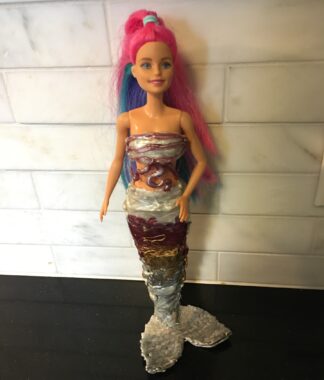What mermaid tails and hot skillets have taught me
Parenting a child with FA has revealed incredible gifts

When our youngest daughter, Amelia, was 5, she hung twine throughout her bedroom. Then she arranged blankets on top of the strands to create an elaborate tent with sections for rooms. I’d never seen anything like it. It was one example among dozens over the years of how Amelia looks at the world differently.
At that point, Amelia was already showing symptoms of Friedreich’s ataxia (FA), although her diagnosis wouldn’t happen for several years.
There’s a chicken-and-egg question that swirls around our home. Is Amelia highly creative because she was born that way? Or did battling FA and finding creative ways to engage in everyday tasks amplify its manifestation? Regardless of the answer, her need to create sometimes puts my parenting skills to the test.
Like most people affected by FA, thoughts about accessibility weave into the everyday moments of our lives. They’re present with every new project Amelia discovers or creates with excitement. The first that caused a parental dilemma regarding safety involved a Barbie doll, plastic wrap, and a hot glue gun. Amelia was 8, and she had an incredible idea that needed to be executed immediately. She was going to create a mermaid tail for Barbie.
It took the most skilled negotiation I could muster to help her create it while I hovered to protect delicate fingers that struggled with feeling and dexterity. In the moments when I took over, Amelia delivered commands like an artist in residence. She had a vision.

A Barbie mermaid tail and top created by Amelia Hamilton. (Photo by Elizabeth Hamilton)
Imagination opens doors
Since that time, many hot glue gun creations have been crafted under watchful eyes. I try not to helicopter parent, but also want to ensure the established safety rules are being followed.
Then came the ask to wield sharp knives. She had a new vision that involved elaborately cut vegetables and diced fruit displayed on a porcelain plate that she needed to carry — alone.
First, we used the skin-safe kid knives for a few months until rolling eyes from a frustrated artist demanded an upgrade. Knife-resistant gloves were purchased and stations were created at the table with a supportive chair and the materials needed to make the vision come alive. When the first plate broke, we talked through new options for the task at hand and ways to do them safely.
The budding chef did not want to stop there. Baking was the new craft, and icing was her medium, as well as melted chocolate and baked goods. Hot pans, sizzling skillets, and a determined child have created a test kitchen of sorts in our home. When asked why certain devices exist in our kitchen, I reply, “It’s an Amelia thing.”
What Amelia continues to teach me, as she builds and creates in situations that seem beyond her ability, is that imagination can open doors originally thought closed. Every problem usually has multiple solutions; we just need to look for them in a unique and determined way. I face the dichotomy of advocating for her needs while also making sure I’m not limiting her. It requires constant recalibration as I work to tear down walls and barriers as she moves forward with a vision for her life.
When Amelia was 5, I told her that she couldn’t build a tent in her room because she didn’t have the right furniture. Instead of listening, she used twine and built something greater than I could’ve imagined.
Here’s to the incredible gifts our children possess. May the world see them, embrace them, and break down the barriers before them.
Note: Friedreich’s Ataxia News is strictly a news and information website about the disease. It does not provide medical advice, diagnosis, or treatment. This content is not intended to be a substitute for professional medical advice, diagnosis, or treatment. Always seek the advice of your physician or another qualified health provider with any questions you may have regarding a medical condition. Never disregard professional medical advice or delay in seeking it because of something you have read on this website. The opinions expressed in this column are not those of Friedreich’s Ataxia News or its parent company, BioNews, and are intended to spark discussion about issues pertaining to Friedreich’s ataxia.








Comments